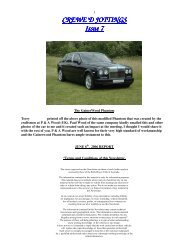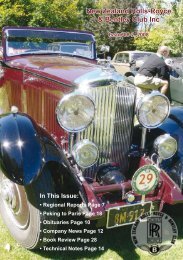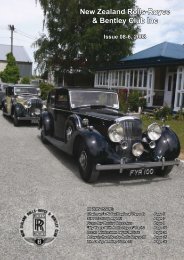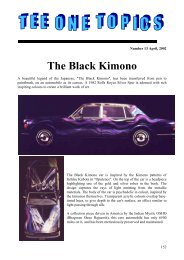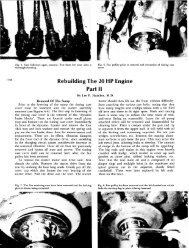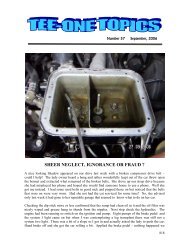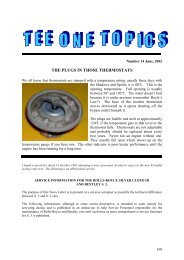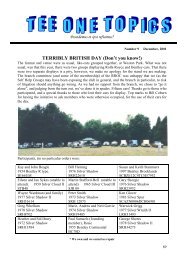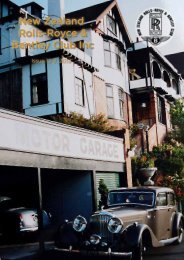Issue 34b - The Enthusiasts Website for Roll-Royce & Bentley Motor ...
Issue 34b - The Enthusiasts Website for Roll-Royce & Bentley Motor ...
Issue 34b - The Enthusiasts Website for Roll-Royce & Bentley Motor ...
Create successful ePaper yourself
Turn your PDF publications into a flip-book with our unique Google optimized e-Paper software.
To assess the colour of the finished veneer apply the spirit wipe to its surface using a pad. Water<br />
will achieve the same thing but will raise the grain necessitating further sanding. Spirit wipe<br />
dries out fairly quickly but you will have quite a few seconds to judge whether the colour is<br />
acceptable. <strong>Roll</strong>s-<strong>Royce</strong> generally used stains or paints to darken the appearance but the natural<br />
colour is often quite acceptable <strong>for</strong> the veneered areas. <strong>The</strong> top of the waist rails however will be<br />
solid mahogany on your car and this will appear very light after lacquering so you will probably<br />
feel the need to darken these, often quite considerably, as did the factory. Staining and painting<br />
is done in stages with individual areas being masked off one at a time to avoid affecting adjacent<br />
areas. <strong>The</strong> instrument openings and end sections are painted in using a brush, ideally an<br />
airbrush, using cellulose paint over the bare wood. Spirit wiping will also highlight any defects<br />
such as areas filled during the original production. <strong>The</strong>se too need painting in and once again an<br />
airbrush is the best way to do this. As a book match is used if any area is painted in on one leaf<br />
of veneer every other leaf should be similarly touched in. This would mean eight touch in’s<br />
across the early Spirit and Shadow dash or <strong>for</strong> a set or waist rails or a pair of picnic tables. After<br />
the touch in has dried re apply the spirit wipe and assess how good it looks. If you are not happy<br />
wash it off with thinner or lightly sand it be<strong>for</strong>e repeating the process. If you find areas that need<br />
filling, as is frequently the case, use a two part wood filler, which a specialist timber merchant<br />
should be able to supply in various colours. Mix it according to the directions, fill the defects<br />
and then sand them smooth. Finally paint them in.<br />
Burr walnut naturally contains black so I would suggest using black to paint in any and all<br />
defects. Black will look 100% convincing if applied correctly and very little practice is actually<br />
required <strong>for</strong> small areas. Other veneers however do not have this advantage and some, like birds<br />
eye maple, are almost impossible to make convincing repairs over.<br />
<strong>The</strong> ideal finish is flexible polyester <strong>for</strong> a variety of reasons but this is not really an option<br />
unless you can find a company to apply it <strong>for</strong> you. This gives the required thickness in one<br />
operation instead of requiring time spent building layers. Polyesters are used <strong>for</strong> finishing<br />
musical instruments like pianos and guitars and frequently used <strong>for</strong> decorative features in luxury<br />
yachts. You may get lucky finding such a specialist. <strong>The</strong>re are a few excellent non-sand varieties<br />
that can give a very good finish almost to the standard of the original. <strong>The</strong> very finest finish<br />
however is only obtained using the varieties designed to be sanded and polished.<br />
Polyurethane lacquer will give good results but it will take many coats and several sanding<br />
operations to build the required thickness to fill the grain and provide a flat surface <strong>for</strong><br />
polishing, it can be brushed or sprayed. Avoid fact drying cellulose or acrylic lacquers as these<br />
will crack very quickly as they lack the necessary flexibility. <strong>The</strong>y will also soften all the areas<br />
painted in which may streak if you brush over them. Two pack clear coats, particularly high<br />
solids varieties, used <strong>for</strong> painting cars are probably the next best alternative to polyester but<br />
there are very real health implications involved when spraying them. Any car paint shop can<br />
apply the lacquer <strong>for</strong> you and they may be willing to do this <strong>for</strong> a reasonable cost as they can<br />
easily combine small pieces with other work requiring clear coat spraying. Although they will<br />
probably not have any experience of wood finishing just tell them to apply three sets of coating<br />
with a light rub down with scotchbrite in between. You will then need to wet sand, using P600<br />
or P800 wet or dry paper and a hard rubber block to level the surface. Take your time and wipe<br />
and dry the surface frequently to assess the progress. Polyester builds very well and rubbing<br />
through is never a problem but it is a very real danger with any other coating so take special care<br />
on edges. Now take the wood back to the paint shop and get them to apply another couple of<br />
sets of clear. You will then need to wet sand with P800 wet or dry paper to remove any “gun<br />
texture” and any residual sinkage into the grain. Follow up with P1200 and then polish using a<br />
494



